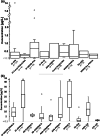"Spice"-related deaths in and around Munich, Germany: A retrospective look at the role of synthetic cannabinoid receptor agonists in our post-mortem cases over a seven-year period (2014-2020)
- PMID: 37072496
- PMCID: PMC10247575
- DOI: 10.1007/s00414-023-02995-2
"Spice"-related deaths in and around Munich, Germany: A retrospective look at the role of synthetic cannabinoid receptor agonists in our post-mortem cases over a seven-year period (2014-2020)
Abstract
Synthetic cannabinoid receptor agonists (SCRAs, "Spice") are a diverse group of recreational drugs, with their structural and pharmacological variability still evolving. Forensic toxicologists often rely on previous reports to assess their role in intoxication cases. This work provides detailed information on the "Spice"-related fatalities around Munich, Germany, from 2014 to 2020. All cases underwent an autopsy. Pharmaceutical and illicit drugs were detected and quantified in post-mortem peripheral blood or liver by liquid chromatography-tandem mass spectrometry (LC-MS/MS). Based on circumstantial evidence, only those cases for which a prior consumption was suspected underwent additional analyses for SCRAs and other new psychoactive substances in post-mortem blood, liver or antemortem specimens. Drug concentrations, pathological findings at autopsy and case histories were considered to assess and rank the SCRAs' involvement in each death. Concentration ranges for the individual substances in blood were defined and their distribution patterns over the investigated period were determined and correlated with their legal status and local police seizures. We identified 41 different SCRAs among 98 fatalities. 91.8% were male, at a median age of 36 years. SCRAs played a causative role in 51%, contributory role in 26%, and an insignificant role in 23% of cases. In correlation with local police seizures and legal status, 5F-ADB was the most prevalent in our cases, followed by 5F-MDMB-PICA and AB-CHMINACA. Cumyl-CBMICA and 5F-MDMB-P7AICA were among the least frequently detected SCRAs. "Spice"-related fatalities and SCRAs' causative role have significantly decreased among our cases since the German New Psychoactive Substances Act.
Keywords: Fatal intoxication; New psychoactive substances (NPS); Post-mortem toxicology; Synthetic cannabinoid receptor agonists (SCRAs,“Spice”); Toxicological Significance Score (TSS).
© 2023. The Author(s).
Conflict of interest statement
The authors declare no competing interests.
Figures




References
-
- Wiley JL, Compton DR, Dai D, et al. Structure-activity relationships of indole- and pyrrole-derived cannabinoids. J Pharmacol Exp Ther. 1998;285:995–1004. - PubMed
-
- Uchiyama N, Kikura-Hanajiri R, Kawahara N, Goda Y. Identification of a cannabimimetic indole as a designer drug in a herbal product. Forensic Toxicol. 2009;27:61–66. doi: 10.1007/s11419-009-0069-y. - DOI
-
- United Nations Office on Drugs and Crime (2011) Synthetic cannabinoids in herbal products. https://www.unodc.org/unodc/en/scientists/synthetic-cannabinoids-in-herb.... Accessed 14 Apr 2023
-
- Auwärter V, De Morais J, Gallegos A, et al (2021) Synthetic cannabinoids in Europe – a review. Lisbon, Portugal
MeSH terms
Substances
LinkOut - more resources
Full Text Sources

